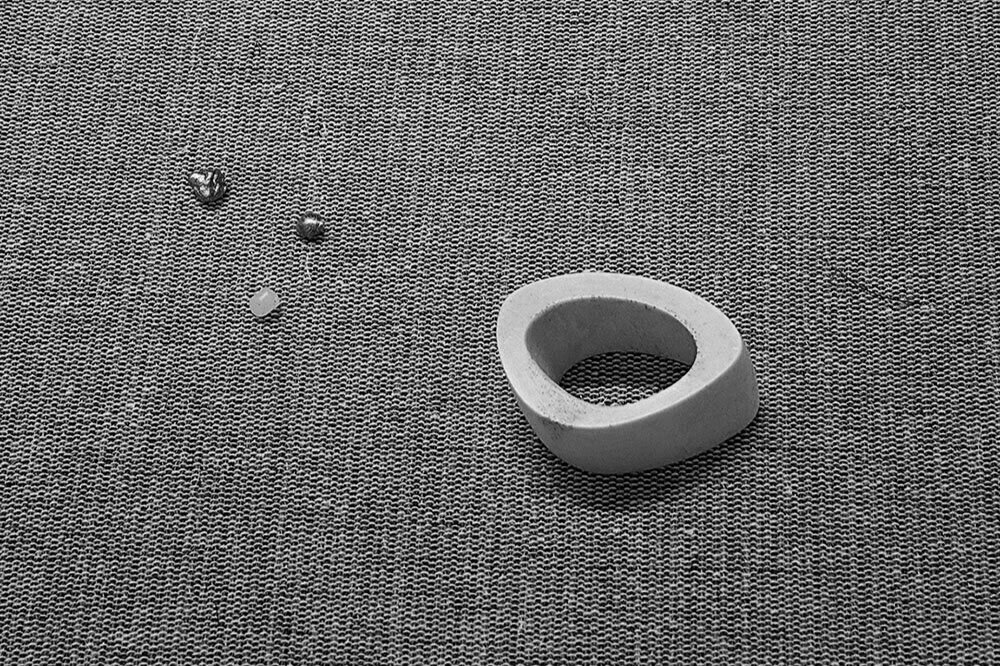
The artist’s approach to sustainability & ethical making
Bone & natural materials
The Jewellers upbringing on the East Coast of New Zealand’s North Island instilled a respect and appreciation for natural resources and their ability to speak for themselves. Through connections to the land and its stories, materials are also an intuitive choice, if not an autobiographical one – paired with precious metals, and sustainable organics such as bone and horn form part of a conversation around both existing and traditional value systems.
All Bone is free-range, grass-fed, hormone-free cattle bone, processed naturally. No chemicals are used, it's done the traditional way with water and sunlight. It is sourced locally in Melbourne from Cannings Free Range Butchers, specifically Cape Grim Beef Bone, the offcuts are used for bone broth or saved for dog friends. The use of bone aims to explore notions of time and impermanence through the intimate nature of jewellery and object. Horn used has been sourced directly from Radford's in Gippsland. Queen Ebony is 100% reclaimed and as such is a rare and precious resource. Cuttlefish used in casting is beachcombed from Bass Coast and Phillip Island, one handful at a time. The offcuts and dust are saved for use in the garden or returned to the beach to resume their destiny as sand.
Gemstones
All chosen materials reflect Liv’s observations concerning industry and the environment and care is taken to ensure the materials are sourced and utilised ethically and sustainably. Diamonds are sourced through suppliers that have been approved by the Kimberly Process, meaning that in relation to production and supply, they are free of conflict and unethical treatment of people, animals and the planet.
Sapphires are sourced from Fair Trade mines in Queensland and NSW, Australia. When considering the source of your purchase, country of origin and the environmental impacts of mining are important factors. On both counts, Australian sapphires have an edge as the local industry is tightly regulated with strict environmental and labour controls. Synthetic gemstones are a low impact alternative if a client has that preference and wishes to request this in their custom piece. With lower prices, a lab-grown gemstone is a practical, modern alternative.
We’re happy to work with clients to create bespoke keep-sake pieces from Memorial Diamonds on request and welcome the use of recycled or heirloom gemstones in our custom pieces.
Precious metals
The gold used, (unless recycled as ‘old gold’ at a buyer request), is classified as Fairmined, meaning it has been extracted by responsible mining practice which is audited to ensure that both social and environmental standards are met by artisanal and small-scale mining organisations throughout the supply process. It is fully compliant with the LBMA Responsible Gold Guidance and the Organisation of Economic Co-operation and Development (OECD). All gold chain is handmade in Melbourne.
Wherever possible, Australian recycled sterling silver and gold is utilised for fine sheet and wirework. For more information about the sustainability practices of our main supplier of precious metals, visit Palloy’s (formerly A&E Metals).
For sentimental reasons, many people prefer to use ‘old gold’ that has been passed down as a family heirloom in their modern pieces. Due to the many variables at play, this process is enquiry based and we are happy to consult with you on this.
Up-cycled objects
Liv reclaims industrial byproducts and marine debris, and makes arrangements of washed-up parts and leftovers, transforming an undervalued resource into sculpture, installation and wearable objects.
A pair of earrings made with shards of plastic collected from the local tideline and embellished with gold, or an abandoned fishing line reimagined in precious metals. Everyday waste becomes something precious, highlighting our material addiction to plastic and the threat it poses to our marine ecosystems.
Another material used extensively in Liv’s work is Henderson Island Nurdles, tiny granules used to create all plastic products are commingled with coral to form a ‘new sand’, which is now ubiquitous on coasts wherever currents converge.
Knowledge exchange
As part of the artist’s endeavour to contribute to broader social awareness and grow the knowledge-base of the materials and processes that can be used in the production of hand-crafted jewellery, Liv commits time to programmes that share the same values. Exchanging knowledge on methods of working with byproducts such as bone and horn and how to ethically source these materials. Some memorable collaborations being;
Indigenous Makers: Jewellery Development Intensive, NGV Melbourne Design Week
Byproduct: Working with Bone & Horn, Short Jewellery Course.
Locally handcrafted
Liv’s body of work has always been accompanied by a commitment to thoughtful sourcing and upholding traditional craft techniques. Hand-forged sections of silver and gold become twigs and koru, coiled together with simple tension. The skin of the metal is weathered by blows of the hammer, replicating the texture crafted by nature with the incessant pounding of waves.
All our pieces are made by hand in our Melbourne workshop, with specialist aspects carried out in the studios of other local artisans close by. We only carry a minimum of stock and do not produce in bulk. Quality over quantity is the basis of our ethos when it comes to creating timeless pieces that can be worn across changing seasons and occasions.







